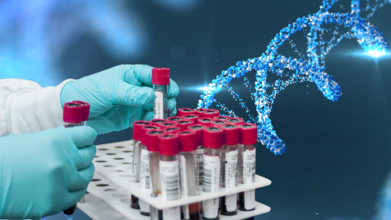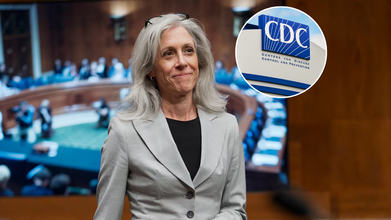- Health Conditions A-Z
- Health & Wellness
- Nutrition
- Fitness
- Health News
- Ayurveda
- Videos
- Medicine A-Z
- Parenting
- Web Stories
UK Approves RSV Vaccination For Ages 60 And Over

Credits: Canva
Good news for Britain, its health regulator on Friday has approved Moderna's MRNA.O vaccine for respiratory syncytial virus in adults over 60 years of age. The shot, also known as the mRESVIA is used for preventing the lower respiratory tract disease in older adults. As per the Medicines and Healthcare products Regulatory Agency (MHRA), RSV is a common virus that spreads easily and could cause infections, which may be mild, cold-like, but can also result into more serious problems like lung infections or even pneumonia.
What is RSV?
As per the Centers for Disease Control and Prevention (CDC), it is a common respiratory disease that infects your nose, throat and lungs and can often make it difficult to distinguish between a common cold or other respiratory viruses like the flu or even COVID-19. It mostly spreads during the fall and winter season and peaks around December and January.
Who Are More At Risk?
The youngest and the oldest population are the most vulnerable to this disease. It usually does not cause any severe illness in healthy adults or children, however, people with RSV, who are older or are infants, which means younger than 6 months of age, could become very sick. They may be need to be hospitalized.
It can also cause other severe illnesses like bronchiolitis, which is the inflammation of the small airways in the lungs, and even pneumonia, which is an infection of the lungs. It is most common cause of these two diseases in children who are younger than 1 year of age.
What Helps When A Person Has RSV?
In most cases, a person may require:
Additional oxygen
IV fluids, in case the person is unable to drink to stay hydrated
Intubation, which is a breathing tube inserted through mouth and down the airway with mechanical ventilation
RSV In Older Population
Why the vaccination for older people important? It is because what seems like a small respiratory issue could be dangerous for older people. In the US alone, each year, 100,000-150,000 adults ages 60 get hospitalized due to RSV, notes the CDC. Adults are thus at the highest risk for severe RSV, thus the UK approval for the vaccination is welcomed warmly.
Another reason why it affects older population more severely, because of their age and by then the body either starts shutting down or their functions slow down. Also, many adults may have comorbidities or other underlying health issues like a chronic heart or lung disease, weakened immune system, or are living with underlying medical conditions or are living in nursing homes. In such adults, RSV can sometimes lead to conditions like asthma, chronic obstructive pulmonary disease or the COPD, which is a chronic disease of the lungs that makes it hard to breathe, and heart failure, because the heart cannot pump enough blood and oxygen through the body.
Who Should Get The Vaccine?
As per the National Health Service (NHS) UK, if you are pregnant, you must get vaccinated, from the 28th week onwards to help protect your baby after they are born. Also, if you aged between 75 to 79, you must too get vaccinated. However, the new vaccine allows the elderly population under the bracket of 65 to be vaccinated too.
Eating More Ultra-Processed Foods Linked to 41% Higher Lung Cancer Risk, Study

Ice cream, breakfast cereal, and that quick-fix instant noodle packet might save a lot of your time and satisfy your taste buds. But a growing body of research suggests they may be doing more harm than just expanding your waistline. A new study has drawn a strong link between eating ultra-processed foods (UPFs) and a significantly higher risk of developing lung cancer.
Here is what you need to know about the findings and whether your daily diet might be putting your lungs at risk.
The study, led by Chinese researchers and published in the medical journal Thorax, tracked the health and food habits of over 100,000 American adults, with an average age of 63, for around 12 years. Using detailed dietary questionnaires, researchers zoomed in on the intake of UPFs, which include all your guilty pleasures: cakes, cookies, soft drinks, frozen pizzas, hot dogs, margarine, sugary cereals, and yes, even your beloved salty snacks.
Participants consumed anywhere between half a serving to six servings of these foods daily, with the average landing at nearly three servings a day. Lunch meats and soft drinks came out on top as the most commonly consumed items.
Also Read: Can Potatoes Help Control Obesity? Researchers Say Yes; Know Why, How and More
By the end of the study, 1,706 participants had developed lung cancer. When researchers compared diets, a disturbing pattern emerged: those who ate the most UPFs had a 41 per cent greater chance of developing lung cancer compared to those who ate the least.
It is Not Just About Smoking
Naturally, the study controlled for smoking status, an obvious and major risk factor for lung cancer. But the researchers admit they could not account for smoking intensity, a variable that could skew results. Still, the pattern remained strong even when separating out different lung cancer types, including both small cell and non-small cell variants.
Reports say that a quarter of lung cancer cases occur in non-smokers, and this highlights the need to explore other possible triggers, including diet.
However, the study is not airtight. Dietary habits change a lot over 12 years, and participants only logged their UPF intake at the start.
What is the Study Actually Saying?
The study’s authors are not claiming that UPFs cause lung cancer. But the association is strong enough to spark concern. They say global efforts to cut back on ultra-processed foods could be an effective way to reduce lung cancer cases, especially among non-smokers.
They are not wrong. While the direct line between a cupcake and a cancer cell has not been proven, UPFs are already known to contribute to obesity, heart disease, type 2 diabetes, and even depression. Adding lung cancer to the list, even with some scientific caveats, raises the stakes for rethinking what is on your plate.
Vaping May Be Rising, But Smoking Is Falling
On a related note, separate research from the University of Michigan offers a silver lining: teenage smoking is on the decline. Tracking data on 16- and 17-year-olds in Britain from 1974, 1986, and 2018, the study showed a drop from 33 per cent to 12 per cent in teen smoking. But in 2018, 11 per cent of teens reported using e-cigarettes instead.
That is still a win in the long-term fight against lung cancer, but it also makes lifestyle-related risks like diet more significant. If fewer people are smoking, then other contributors to lung cancer, like poor nutrition, could become even more important to understand.
Should You Panic or Not?
The science is not settled, and researchers are being cautious. Still, the message is clear: even if you have never lit a cigarette in your life, what you eat might be silently setting off alarms in your body.
While more studies are needed to confirm causation, this new research adds to a growing chorus warning us about the dangers of overly processed meals. You do not need to quit cake completely, but maybe it is time to take care of your lungs more by making better food choices.
Why Are Only Certain People At Risk Of Developing MS? World's First Study Aims To Crack The Code

Credits: Canva
Multiple sclerosis (MS) remains one of the most complex neurological conditions with no known cure. Affecting over 33,000 Australians and 2.8 million people globally, MS continues to baffle scientists and clinicians alike. While environmental factors, genetics, and viral infections have all been linked to MS, no single cause has been confirmed.
Now, a world-first study from the University of South Australia may finally crack part of the code. For the first time, researchers are using a genetic selection method called recall by genotype to understand why some people exposed to the same virus go on to develop MS while others don’t.
At the heart of the study is a long-suspected culprit: the Epstein-Barr virus (EBV), best known for causing glandular fever. More than 90% of the global population gets infected with EBV at some point. Yet only a small fraction develop MS. That’s where the mystery lies- how can one virus lead to a life-altering autoimmune disease in a select few?
Dr. David Stacey, who leads the study, believes the answer may lie in our genes. “It’s like studying the immune system’s blueprint before the disease starts,” he said. The goal is to identify how individuals’ genetic make-up alters their immune response to EBV—and whether that difference tips the scale toward developing MS.
What Is the ‘Recall by Genotype’ Approach?
This isn’t just another observational study. The team is using an innovative approach known as recall by genotype, a first in MS research. In simple terms, they’ll analyze the DNA of more than 1,000 participants who have never been diagnosed with MS. These individuals will then be grouped into high-risk and low-risk categories based on their genetic predisposition to MS.
From there, researchers will compare how the immune systems in these two groups respond to EBV exposure.
“By grouping people based on their genetic profile, we expect to find those with a high genetic risk for MS will also show biological differences—even if they don’t have the disease,” explained Dr. Stacey.
This could help pinpoint biomarkers—early warning signs in the body that MS may be developing long before symptoms appear.
Why This Study Could Be a Game-Changer?
MS is a central nervous system autoimmune disorder. It causes the immune system to attack the protective sheath covering nerve fibers, resulting in symptoms like fatigue, muscle weakness, poor coordination, vision problems, and cognitive changes. But the progression of the disease is highly unpredictable.
This study, funded by MS Australia’s Incubator Grant program, aims to do more than just explain risk. It could transform the way we approach MS—shifting from reactive care to proactive detection and even prevention.
“If we can identify biological markers before symptoms begin, that opens up new possibilities for early interventions or therapies that could delay or stop disease progression altogether,” said Dr. Stacey.
Does High Genetic Risk Mean Someone Will Develop MS?
With genetic research comes another layer of complexity: how much risk information should be shared with participants? Dr. Stacey acknowledges that just because someone has a high genetic risk doesn’t mean they’ll definitely develop MS. That brings up ethical and legal challenges. “If we identify people who are at risk of developing MS, we need to consider how—and whether—to share that information, particularly as it may not yet be clinically actionable,” he said.
Part of the study will address these questions and help lay the groundwork for responsible, patient-centered practices in future genetic research.
While this study is based in Australia, its implications are far-reaching. MS is a leading cause of neurological disability among young adults worldwide. The hope is that by identifying the biological chain of events leading to MS, scientists can develop tools that apply globally—regardless of geography, ethnicity, or background.
According to Rohan Greenland, CEO of MS Australia, “Our mission is to accelerate research and improve outcomes for every person living with MS.” This project exemplifies that vision by targeting the earliest stages of the disease—before symptoms even appear.
If the pilot is successful, it will inform a much larger, more ambitious study. Researchers plan to refine how genetic risk scores are calculated, validate their findings across diverse populations, and develop standardized operating procedures for similar studies worldwide.
This could also inspire studies into other autoimmune conditions like lupus or type 1 diabetes, where viral triggers and genetic susceptibility are believed to intersect.
The world's first “recall by genotype” study in MS research is underway in Australia. By linking genetic risk to immune response against the Epstein-Barr virus, scientists aim to answer a longstanding medical mystery: why only some people develop MS. The findings could pave the way for earlier detection, targeted therapies, and ethical frameworks for sharing genetic information—all with global implications.
Who Is Susan Monarez? The New CDC Director Confirmed By The US Senate

Credits: AP/ CDC
In a closely watched vote, the U.S. Senate confirmed Dr. Susan Monarez as the new Director of the Centers for Disease Control and Prevention (CDC), marking a pivotal moment for an agency under intense political and public scrutiny. The 51-47 confirmation made Monarez the first CDC director to be Senate-confirmed under new legislation passed in 2023. The appointment follows months of leadership vacuum and ideological rifts inside the CDC that have fueled uncertainty in public health circles.
Monarez now steps into a role that has become as much about crisis management and restoring public trust as it is about public health science.
Who Is Susan Monarez?
At 50, Dr. Susan Monarez brings a formidable résumé steeped in science, biosecurity, and federal health policy. She holds a PhD in microbiology and immunology from the University of Wisconsin and completed her postdoctoral training at Stanford University. Before joining the CDC, Monarez served as Deputy Director at the Advanced Research Projects Agency for Health (ARPA-H), a government agency known for funding innovative biomedical research.
Her career spans multiple federal agencies including the Department of Homeland Security, the Health Resources and Services Administration, the Office of Science and Technology Policy at the White House, and the Biomedical Advanced Research and Development Authority (BARDA). These roles have given her deep exposure to health innovation, disaster preparedness, and pandemic response policy.
Also Read: Why Are Only Certain People At Risk Of Developing MS? World's First Study Aims To Crack The Code
Monarez has also led the development of national strategies to combat antibiotic resistance, close maternal health gaps, expand telehealth, and ensure the ethical use of health data. Her work has been consistently focused on bridging science and policy to tackle real-world health threats—both globally and domestically.
Monarez’s confirmation ends a stretch of instability at the CDC, which has been operating without a permanent director since early 2025. The agency has faced major staff losses, widespread morale issues, and increasingly vocal political pressure. President Trump’s initial nominee, David Weldon, was withdrawn unexpectedly, and Monarez was named acting director in January before being formally nominated in March.
During her confirmation hearing, Monarez maintained a diplomatic stance affirming her support for vaccines and science-based policy—while skirting direct questions about her relationship with Health Secretary Robert F. Kennedy Jr., whose controversial antivaccine positions have sparked upheaval within the agency. Kennedy has taken bold steps to sideline CDC authority, including bypassing the agency earlier this year to roll back COVID-19 vaccine guidance for pregnant women and children.
That move underscored the new reality Monarez inherits: a CDC whose power and relevance in setting public health policy is being redefined in real-time.
At her Senate hearing, Monarez was clear about her priorities: rebuilding public confidence in the CDC, modernizing outdated data infrastructure, and preparing for future infectious disease threats. These are not minor tasks. The CDC has suffered from a credibility gap over the last several years, exacerbated by mixed messaging during the COVID-19 pandemic, political interference, and what many in the public saw as a lack of transparency.
“She brings decades of distinguished experience in health innovation, disaster preparedness, global health, and biosecurity to CDC,” the agency said in a social media post following the vote. “Dr. Monarez will lead efforts to prevent disease and respond to domestic and global health threats.”
But restoring trust will take more than credentials. The CDC’s internal structure and external messaging need overhauling to match the expectations of a more skeptical and divided public. Monarez is taking over an agency in flux—both scientifically and politically.
Science and Strategy Behind the Leader
Monarez’s scientific work reflects a global and future-forward perspective. She has spent her career at the intersection of technology and health policy, especially in biodefense and medical preparedness. At ARPA-H, she helped direct funding toward tools for rapid disease detection, AI-driven health diagnostics, and innovative solutions for behavioral health and maternal care disparities.
She has also been deeply involved in policy development at the national level, helping craft presidential action plans and leading interagency coordination on issues ranging from pandemic preparedness to organ transplantation reform. In previous roles, she worked directly on combating multi-drug-resistant infections and led international collaborations with the EU, Canada, France, and others on biosecurity measures.
This blend of strategic vision and scientific rigor is exactly what public health experts say the CDC needs now—particularly in an era where emerging infectious diseases, misinformation, and technology disruptions often collide.
What’s Next for the CDC Under Monarez?
Monarez is stepping into the role amid mounting public health challenges. Vaccine skepticism is on the rise, federal funding for the CDC is set to be slashed under the 2026 budget proposal, and chronic disease burdens continue to grow alongside new threats like drug-resistant bacteria and climate-related health crises.
Her immediate task will be internal stabilization—building back teams, reaffirming scientific values, and reestablishing CDC leadership across state and local public health departments. Externally, she must walk a careful line: maintaining scientific integrity while navigating a politically volatile environment.
Already, her ability to operate in this tension-filled space is under watch. While her academic and professional pedigree earns her respect in science circles, her willingness—or reluctance—to directly challenge political directives from Secretary Kennedy and the White House will define her legacy at the CDC.
Susan Monarez’s confirmation is more than a personnel change; it signals a recalibration of how public health leadership will work in today’s polarized environment. Her track record suggests she understands the complexity and weight of the role.
The real test now is whether she can reassert the CDC’s voice in public health, without becoming another casualty in the ongoing tug-of-war between science and politics.
© 2024 Bennett, Coleman & Company Limited

